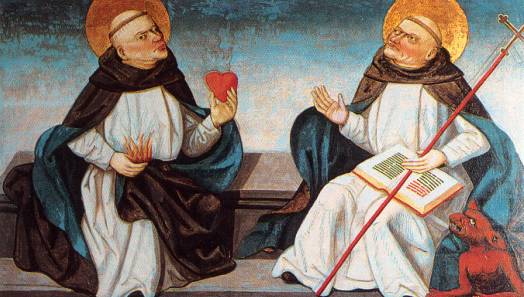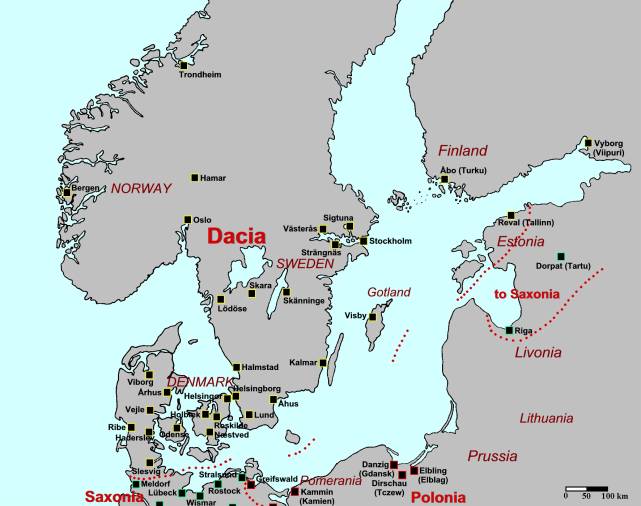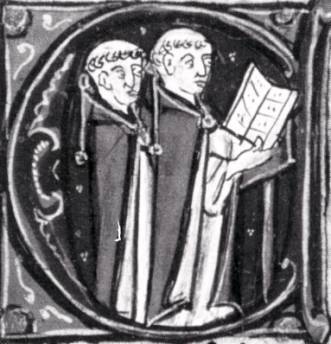
Centre for Dominican Studies of Dacia
Dominicans in Dacia : The role of Friars Preachers in medieval Scandinavian society
Presentation of planned postdoctoral project by Johnny Grandjean Gøgsig Jakobsen, supported by the Danish Research Council of Culture and Communication (Forskningsrådet for Kultur og Kommunikation) for two years, affiliated to the Department of Scandinavian Research, University of Copenhagen 2009-2013.

The
aim of my postdoctoral project is to analyse and identify ‘The role of
Friars Preachers in medieval Scandinavian Society’. The Order of Preachers,
today better known as Dominicans, arrived in Scandinavia in the 1220s and
remained here for the next 300 years until the friars were forced to leave due
to the Lutheran Reformation. By that time, 31 Dominican convents existed in
Scandinavia, constituting the province of Dacia. Unlike brethren of the
old monastic orders, Dominican friars were expected to interact with the
surrounding society as much as possible, helping people become better
Christians. Furthermore, as mendicants - i.e. without owning rent-giving
property - the friars were forced by their own constitutions to keep an
extraordinary close contact to their lay and ecclesiastical neighbours in order
to survive. This extroverted focus, both out of ideal and necessity, combined
with the number of convents, often located in ecclesiastical and economical
urban centres, made the Friars Preachers an important factor in various ways in
the society of high and late medieval Scandinavia. It is this many-sided role in
society that my project wishes to clarify.

The
project is based on a complete and systematic registration of all published
written evidence from the Middle Ages mentioning Dominican friars or their
priories in Scandinavia. This registration, which constitutes an important part
of the project itself, is already done for Denmark as part of my PhD, but
remains for the rest of Scandinavia. The registered material will be analysed
for a number of themes concerning the everyday role of Dominican friars in
medieval Scandinavia, and thus their importance and potential influence on the
local, regional and national society in which they took part. The themes include
Dominican preaching and hearing of confessions, rural terminatione (i.e.
the friars’ activities outside their home towns), public access to and use of
Dominican churches and priories, relations between Dominican convents and
various groups of society, the socio-political importance of having a mendicant
priory in town, the physical location of priories within the urban geography,
Dominican possession of real estate, and the friars’ participation in local
inquisitions, crusades and missionary activities. Finally, I will take on the
question of the Dominicans as possible “agents of Europeanisation” in
Scandinavia in regard of transmitting new ideas, rituals and systems from
Continental Europe to the North - and perhaps to some degree vice versa.
In each thematic chapter, related scholarly traditions will be presented
and held up against the actual Scandinavian evidence. As an important part of
the study, the Scandinavian observations will be compared to related studies
from other Dominican provinces of Northern Europe. This comparative analysis has
several aspects. It aims to contribute to recent scholarly attempts to place
Scandinavian medieval history in a larger European context. On a more practical
term, by comparing the Nordic evidence with observations from the rest of
Northern Europe, it is possible to increase the total amount of observations and
thereby the general validity of the derived interpretations. In addition, we can
look for possible differences between the provinces in order to judge whether
Dominican influence on North European society and culture can be regarded as
uniform or regionally varied and perhaps even locally dependent.
Finally, it is worth stressing that my project has an aim that goes
beyond the postdoctoral study itself. An important part of the project idea is
to endorse Dominican studies in Scandinavia and Northern Europe in general. The
registered and transcribed source material is to be made available on my website
initiative Centre for Dominican Studies of Dacia, initially in the form
of a Regesta with short summaries of the content of each piece of
evidence along with information about its date, its archival situation and where
it is published. On a longer perspective (i.e. not within the project period), I
plan to supplement this with an online Diplomatarium of complete
transcripts. Furthermore, bibliographies of Dominican-related literature in
Scandinavia will be listed on the website. Hopefully, this will ease the
creation of networks between interested scholars within and outside Scandinavia.
The
described postdoctoral project can be seen as an extended continuation of the
work in my PhD dissertation on “Prædikebrødrenes
samfundsrolle i middelalderens Danmark”, which I made at the
University of Southern Denmark in 2005-08. For this doctoral thesis, I did a
similar, complete registration of Dominican references in the published source
material of medieval Denmark, based on which I took up a number of the themes
mentioned above and performed a comparative analysis with studies from
especially North-Western Europe. The present postdoctoral project does, however,
go significantly further on a number of accounts. Firstly, the new project will
include the entire province of Dacia, which means an additional inclusion of the
material from Sweden, Norway, Finland, Iceland, and Tallinn. Secondly, the new
project will take up a number of questions left out of the PhD dissertation. For
instance, I want to give more attention to the relation between Nordic
Dominicans and the royal powers, where this can be said to have influenced the
general Dominican role in society. I will also dedicate a chapter to the
internal Dominican-Franciscan relations in Scandinavia, just as the inclusion of
the Dominican role as possible agents of Europeanisation is new. From my Danish
studies, it appears as if Dominican influence was particularly evident among lay
women, something which I wish to look further into in the postdoctoral project,
for which not least the Swedish material should offer promising possibilities.
Thirdly, as I have gained some very good contacts to archaeologists around
Scandinavia with experience in excavating Dominican priories, I hope and believe
it will be possible to include a lot of their recent discoveries and ideas.
Finally, the postdoctoral project will be written in English.
I
believe that my project will be of great value for the understanding of medieval
Dominican history in Scandinavia in a broad religious, culturally,
socio-historic, and international sense. When reading traditional presentations
of Dominican engagement in medieval Scandinavia in both popular and scholarly
literature, it is difficult to comprehend how these apparently starry-eyed
theologians and soon rather decadent friars managed to survive as an order in
our latitudes for more than three centuries, when one keeps in mind that the
everyday-survival of the convents was completely dependent on the generosity and
support of the surrounding society. In the last 25-30 years, a number of studies
from around Europe has shown how Dominicans continuously adapted to the changing
conditions in society, a society in which the friars and their priories played a
much more extensive and integrated part than traditionally thought. Due to the
number of different societal themes with concern to the Dominican Order that my
project will look into, it is impossible here to account for all the related
traditional views and discussions, not to say the present Stand-der-Forschung.
Generally, though, it can be concluded that a line of newer studies from all
over Northern Europe show that when systematically tested with the actual
evidence, almost all the traditional perceptions of the role of Dominican friars
in medieval society need a significant shading - if not, as in some cases, a
complete dismissal. For instance, both Danish and North European studies
indicate that Dominican relations to the secular clergy were much better than
usually claimed, that the traditionally alleged close connection to urban
bourgeoisie did not really kick in until the 15th century, and that
it is difficult to identify any general unpopularity for the friars in late
medieval society until the very eve of the Lutheran Reformation. Furthermore,
the Dominican engagement in pastoral services in the rural countryside (the terminatione)
as well as the integration of Dominican priories in urban society in a number of
non-religious ways will probably come as a surprise to most.
My postdoctoral project can be expected to gain extensive international attention, partly by the mere fact that it will be the first major overall work on Dominicans in Scandinavia written in an international language since the dissertation of Jarl Gallén of 1946. Furthermore, not only did Gallén’s work leave a number of untouched themes to take up, our archaeological knowledge of Dominican priories in Scandinavia have increased significantly in recent years, new written source material has become available, and several similar studies from neighbouring regions in Northern Europe make it possible and interesting to perform comparative studies. However, an overall international study on Dominican roles in medieval society, including and comparing results from different provinces, have not yet been performed, and, thus, the project will not just be of interest in a Scandinavian context. Therefore, it will be logical to publish the major results of the study in an English-languaged book. In addition, I intend to present some of my findings in relevant scholarly conferences in Europe and North America.

Centre
for Dominican Studies of Dacia
Johnny
G.G. Jakobsen, Department of Scandinavian Research, University of Copenhagen
Postal address: Njalsgade 136, DK-2300 Copenhagen, Denmark ● Email: jggj@hum.ku.dk